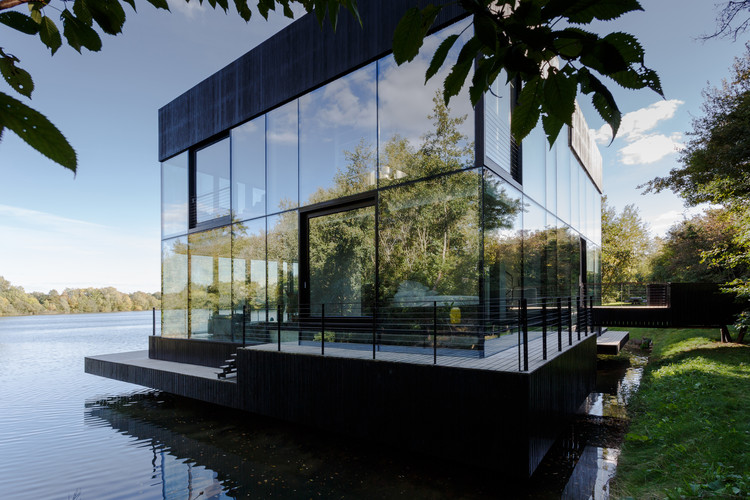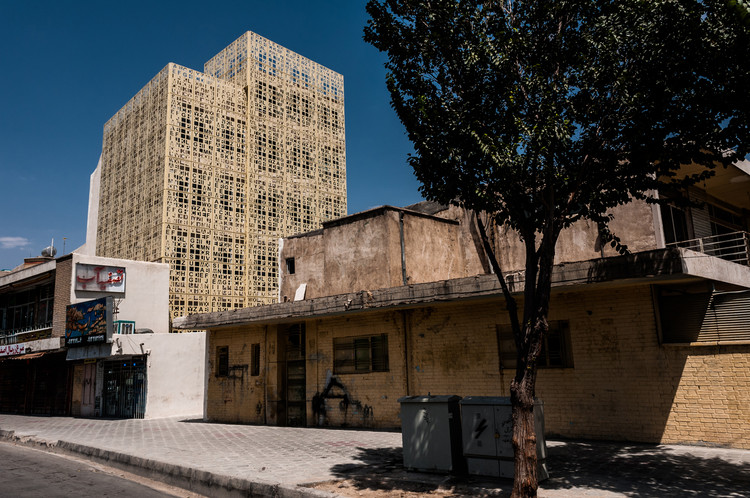skinnySCAR Gwendolyn Huisman and Marijn Boterman
2017-02-20 05:00
© Ossip van Duivenbode
c.OsSIP van Duivenbode
.jpg)

架构师提供的文本描述。这个计划展示了城市中被遗忘的空旷空间是如何被利用的。每个城市都忽略了可以升级以完成城市结构的空间,同时为冒险的城市生活创造了新的形式的可能性。作为年轻的建筑师,Gwendolyn Huisman和Marijn Boterman看到了在鹿特丹的一个古老的社区中缩小和极端比例的差距的潜力和挑战。2012年,他们开始了购买非卖品地块的过程,最近他们自己完成了整个室内设计。
Text description provided by the architects. The skinnySCAR project shows how forgotten empty spaces in the city can be used. Each city has neglected spaces that can be upgraded to complete the urban fabric, while creating possibilities for new forms of urban living for the adventurous ones. As young architects, Gwendolyn Huisman and Marijn Boterman saw the potential and challenge of a narrow gap with extreme proportions in an old Rotterdam neighborhood. In 2012 they started the process to buy the plot that was not for sale, and recently finished the entire interior themselves.
Courtesy of Gwendolyn Huisman and Marijn Boterman
由Gwendolyn Huisman和Marijn Boterman提供


Axonometric


Courtesy of Gwendolyn Huisman and Marijn Boterman
由Gwendolyn Huisman和Marijn Boterman提供


情节的极端比例,只有3.4米宽,20米深,导致了一个堆叠开放的类型,而这是一个构造上的挑战。由于这种相对于高度的狭长,需要一个庞大的地基和承重结构。因此,在房屋内部引入了两个平行钢筋混凝土板的优雅解决方案。这样,正面的开口就不受建设性约束的限制。为了创造宁静的居住空间,建筑师们将住宅所需的所有支撑功能,以及这些混凝土板和装置,集中在房屋中心的两个垂直空间中。这些卷是从侧壁分离,以强调13米深的内部,并创造了不同空间之间的各个方向的意料之外的景象。楼梯的设计方式提高了这些空间的质量。建筑理念强调生活空间的自然分裂,这种空间融合在一起,没有严酷的边界,空间总是水平地和垂直地连接在一起。通过把房间的体积和楼梯靠近中心,亲密的居住空间出现在公共街道和集体庭院花园。居住空间大小适中,感觉亲密,不因建筑景观和空间的流动性而感到压抑。
The extreme proportions of the plot, only 3.4 meters wide and 20 meters deep, result in a stacked open typology while it was a constructional challenge. Being this narrow and long in relation to the height, a massive foundation and load bearing structure were needed. Hence an elegant solution of two parallel reinforced concrete slabs was introduced in the interior of the house. This way the openings in the facades were not limited by the constructive constraints. In order to create tranquil living spaces, the architects have clustered all supporting functions that a dwelling needs, as well as these concrete slabs and installations, in two vertical volumes in the center of the house. These volumes are detached from the side walls to emphasize the 13 meter deep interior and create unexpected vistas in all directions between the different spaces. The staircase is designed in such way that it enhances these spacial qualities. The architectural concepts stresses a natural division of living spaces that merge together without harsh boundaries, where the spaces are always connected horizontally and vertically. By placing the volumes and staircase near the center of the house, intimate living spaces appear towards the public street and collective courtyard garden. The living spaces are moderate in size and feel intimate, without feeling to oppressive due to the architectural vistas and fluidity of spaces.
Ground Floor Plan


Floor Plan 01
楼层图01


Floor Plan 02
平面图02


居住空间的组织反映了它们一整天的使用情况。在一楼是一个宽敞的入口区域和一个开放的厨房,通过高折叠门连接到集体庭院花园。客厅和图书馆主要用于晚上,在一楼,可以看到郁郁葱葱的花园和公共街道。起居室的空隙连接一楼和一楼的起居空间,用作吊床,可以俯瞰花园和天空。图书馆的后海湾窗口延伸到公共街道上,作为一个坐着阅读的地方,并以这样的方式详细描述城市的结构。房子里最私密的部分,卧室和浴室,都位于顶层。浴缸上方的天窗可以俯瞰过往的云彩和鸟类,并将自然的白天光线带入房子的黑暗区域。
The organization of living spaces reflects their use throughout the day. On the ground floor is a spacious entrance area and an open kitchen, connected to the collective courtyard garden through high folding doors. The living room and library, mainly used in the evenings, are on the first floor and look out over the lush garden and public street. A void in the living room connects the living spaces on the ground floor and first level, and is used as a hammock with views over the garden and sky. The deep bay window of the library extends over the public street and is dimensioned to be used as a place to sit and read, and detailed in such a way to frame the urban fabric. The most private part of the house, the bedrooms and bathroom, are positioned on the top floor. A skylight above the bathtub gives views over passing clouds and birds, and brings natural day light into the darker zone of the house.
Courtesy of Gwendolyn Huisman and Marijn Boterman
由Gwendolyn Huisman和Marijn Boterman提供


Courtesy of Gwendolyn Huisman and Marijn Boterman
由Gwendolyn Huisman和Marijn Boterman提供


室内使用的材料既简单又自然。它们给内部带来温暖,而不是支配知觉。这两个立式体积都是用松胶合板包覆的,建筑师夫妇可以自己建造,而现场浇筑的粗糙混凝土地板则没有在天花板一侧完成,以揭示施工方法。混凝土天花板上的锈迹是对浇铸它们的雨季的一种纪念。
The materials that are used in the interior are simple and natural. They bring warmth to the interior without dominating the perception. The two vertical volumes are clad in pine plywood that the architect couple could construct themselves, and the rough in site cast concrete floors are not finished on the ceiling side in order to reveal the construction method. Rust stains on the concrete ceiling are a remembrance of the wet season in which they were cast.
© Vincent van Dordrecht
C.文森特·范多德雷赫特
.jpg)

黑色的砖石立面适合他们的方向:它向花园开放,有一个两层高的玻璃正面和全景窗口,而它仍然是更加私密的公共街道。巴西砌体粘结层的作用是遮住阳光的光线和阴影。只有当房间亮着的时候,他们才会向街道展示隐藏的窗户。带有最少细节的海湾窗户将室内与公共生活联系在一起,居民们可以坐在那里观看路过的人们。街道立面的细节和具体化是这样的,它建立在19世纪末20世纪初的周边城市结构之上。现代住宅与现代细节有其自身的同一性,但仍凸显出历史上城市语境中的微小差距。该项目改变了传统和传统的生活方式,并适合他们的居民作为定制西装。
The black masonry facades are adapted to their orientation: it opens up to the garden with a two storey high glass front and panoramic windows, while it remains more private towards the public street. The Brazilian masonry bond functions as a veil that plays with light and shadows of the sun’s rays. They only show the hidden windows towards the street at night when the rooms light up. The bay windows with a minimum of details connect the interior towards the public life, where the inhabitants can sit and watch people passing by. The street facade is detailed and materialized in such a way, that it builds on the surrounding urban fabric of the late 19th/early 20th century. The modern house has its own identity with modern details, but still highlights the history of the small gap in the urban context. The project transforms a conventional and traditional way of living and is fitted to their inhabitants as a custom-made suit.


























.jpg)

















.jpg)







.jpg)





















Architects Gwendolyn Huisman and Marijn Boterman
Location Rotterdam, The Netherlands
Category Houses
Area 140.0 m2
Project Year 2017
Photographs Ossip van Duivenbode, Vincent van Dordrecht
Manufacturers Loading...































